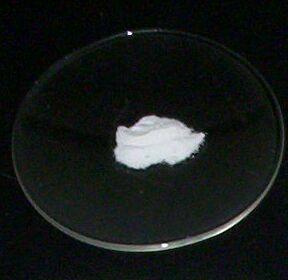Watch glass
Watch glass is a piece of simple yet essential laboratory equipment used in various scientific fields, including chemistry, biology, and physics. A watch glass is a concave piece of glass that resembles a shallow glass dish or lens. It is primarily used in laboratories for evaporating liquids, holding solids while being weighed, or as a cover for beakers.
Uses[edit | edit source]
The versatility of a watch glass extends to several key laboratory procedures:
- Evaporation of Liquids: It is commonly used to evaporate liquids to concentrate the solute in a solution. The broad surface area of the watch glass allows for a faster rate of evaporation compared to other laboratory glassware.
- Covering Beakers: A watch glass can be used to cover a beaker to prevent contamination or to minimize the evaporation of volatile substances.
- Holding Solids: When substances need to be weighed, a watch glass serves as a clean platform that does not add significant weight.
- Observation Platform: It can be used as a surface to observe reactions or to hold specimens under a microscope.
Types[edit | edit source]
Watch glasses come in various sizes, typically ranging from 40 mm to 150 mm in diameter. They are made from different types of glass, depending on the chemical resistance and thermal stability required. Borosilicate glass is a common material due to its resistance to thermal shock and chemical corrosion.
Safety Considerations[edit | edit source]
While using a watch glass, especially during evaporation or heating processes, it is important to handle it with care to avoid breakage. Sudden changes in temperature can cause the glass to shatter, posing a risk of injury. Therefore, gradual heating and cooling are recommended to ensure safety.
Maintenance[edit | edit source]
Cleaning a watch glass after use is crucial to maintain its integrity and to prevent cross-contamination between experiments. It should be cleaned with appropriate solvents and stored in a safe place where it is not at risk of being scratched or broken.
Conclusion[edit | edit source]
A watch glass, though simple in design, plays a crucial role in the laboratory. Its versatility makes it an indispensable tool for scientists and researchers. Proper use and maintenance of a watch glass ensure its longevity and reliability in various scientific applications.
Search WikiMD
Ad.Tired of being Overweight? Try W8MD's physician weight loss program.
Semaglutide (Ozempic / Wegovy and Tirzepatide (Mounjaro / Zepbound) available.
Advertise on WikiMD
|
WikiMD's Wellness Encyclopedia |
| Let Food Be Thy Medicine Medicine Thy Food - Hippocrates |
Translate this page: - East Asian
中文,
日本,
한국어,
South Asian
हिन्दी,
தமிழ்,
తెలుగు,
Urdu,
ಕನ್ನಡ,
Southeast Asian
Indonesian,
Vietnamese,
Thai,
မြန်မာဘာသာ,
বাংলা
European
español,
Deutsch,
français,
Greek,
português do Brasil,
polski,
română,
русский,
Nederlands,
norsk,
svenska,
suomi,
Italian
Middle Eastern & African
عربى,
Turkish,
Persian,
Hebrew,
Afrikaans,
isiZulu,
Kiswahili,
Other
Bulgarian,
Hungarian,
Czech,
Swedish,
മലയാളം,
मराठी,
ਪੰਜਾਬੀ,
ગુજરાતી,
Portuguese,
Ukrainian
Medical Disclaimer: WikiMD is not a substitute for professional medical advice. The information on WikiMD is provided as an information resource only, may be incorrect, outdated or misleading, and is not to be used or relied on for any diagnostic or treatment purposes. Please consult your health care provider before making any healthcare decisions or for guidance about a specific medical condition. WikiMD expressly disclaims responsibility, and shall have no liability, for any damages, loss, injury, or liability whatsoever suffered as a result of your reliance on the information contained in this site. By visiting this site you agree to the foregoing terms and conditions, which may from time to time be changed or supplemented by WikiMD. If you do not agree to the foregoing terms and conditions, you should not enter or use this site. See full disclaimer.
Credits:Most images are courtesy of Wikimedia commons, and templates, categories Wikipedia, licensed under CC BY SA or similar.
Contributors: Prab R. Tumpati, MD




